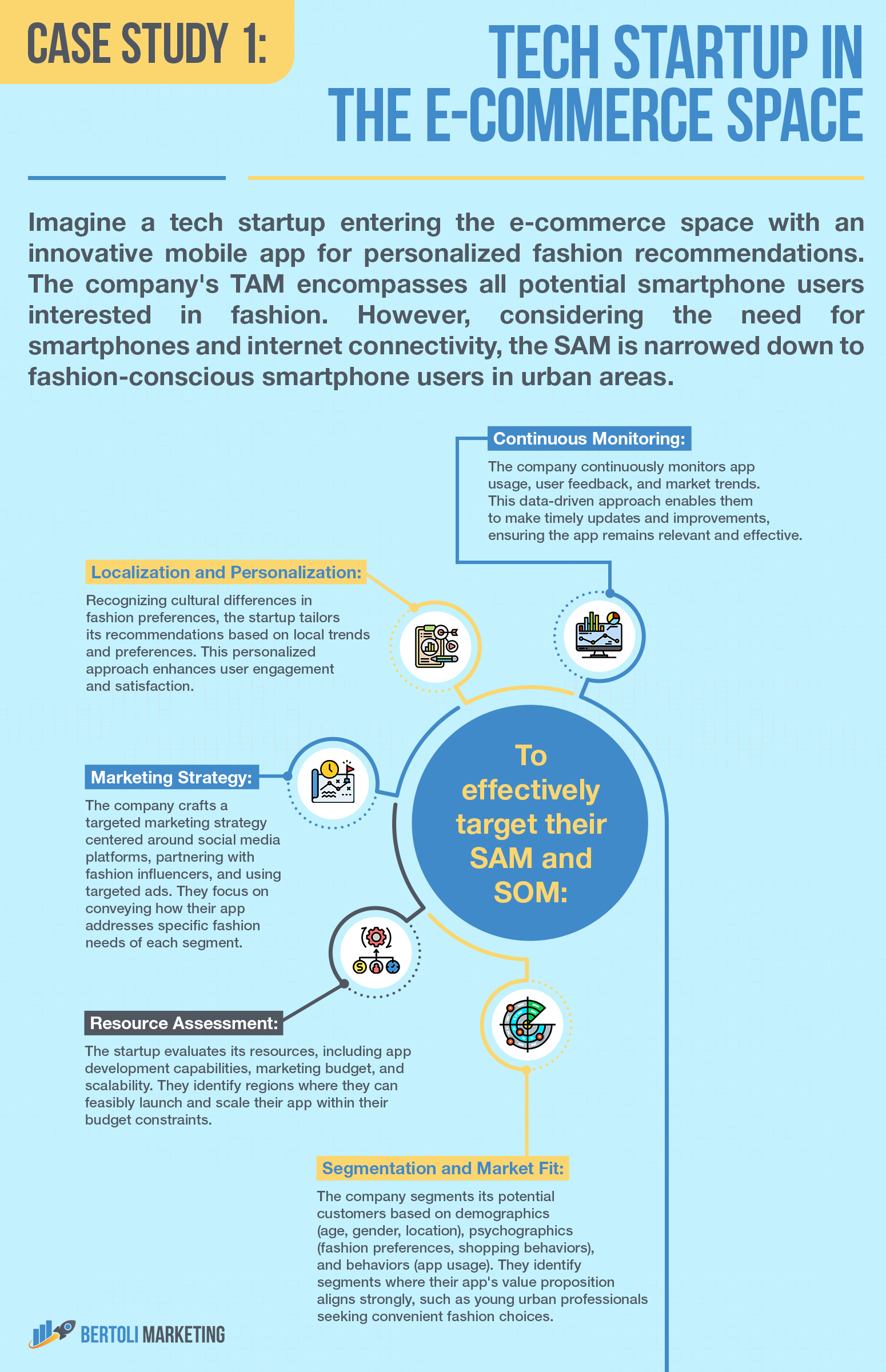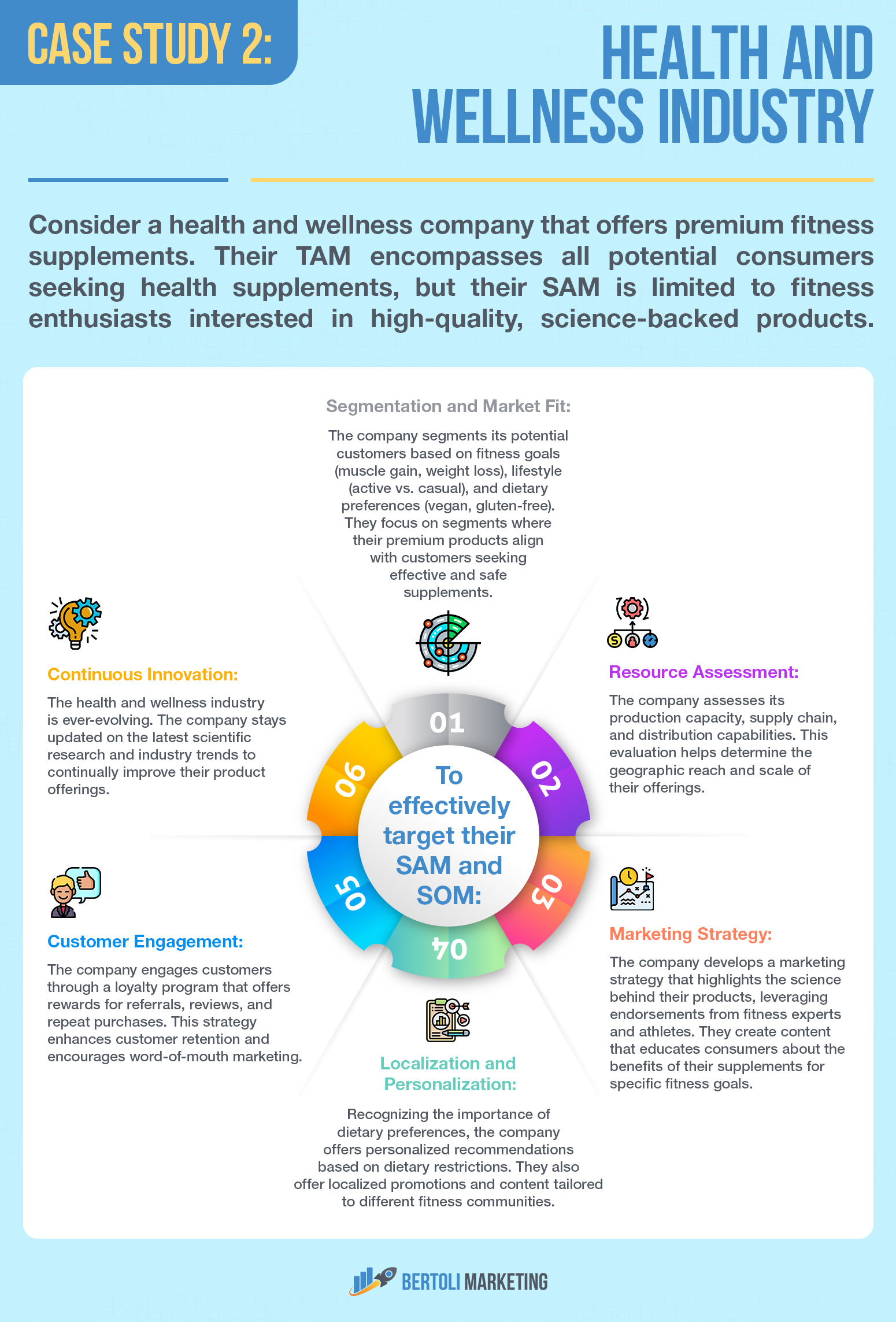
In today’s dynamic business landscape, successful market targeting is paramount to business growth and sustainability. Understanding and effectively segmenting the market is essential for companies seeking to allocate resources wisely, optimize marketing efforts, and capture a meaningful market share. This article delves into the concepts of Total Addressable Market (TAM), Serviceable Available Market (SAM), and Serviceable Obtainable Market (SOM), exploring the significance of each segment and providing insights into strategies for effectively targeting these markets to drive business success.
Imagine a tech startup entering the e-commerce space with an innovative mobile app for personalized fashion recommendations. The company’s TAM encompasses all potential smartphone users interested in fashion. However, considering the need for smartphones and internet connectivity, the SAM is narrowed down to fashion-conscious smartphone users in urban areas.
To effectively target their SAM and SOM:
Segmentation and Market Fit: The company segments its potential customers based on demographics (age, gender, location), psychographics (fashion preferences, shopping behaviors), and behaviors (app usage). They identify segments where their app’s value proposition aligns strongly, such as young urban professionals seeking convenient fashion choices.
Resource Assessment: The startup evaluates its resources, including app development capabilities, marketing budget, and scalability. They identify regions where they can feasibly launch and scale their app within their budget constraints.
Marketing Strategy: The company crafts a targeted marketing strategy centered around social media platforms, partnering with fashion influencers, and using targeted ads. They focus on conveying how their app addresses specific fashion needs of each segment.
Localization and Personalization: Recognizing cultural differences in fashion preferences, the startup tailors its recommendations based on local trends and preferences. This personalized approach enhances user engagement and satisfaction.
Continuous Monitoring: The company continuously monitors app usage, user feedback, and market trends. This data-driven approach enables them to make timely updates and improvements, ensuring the app remains relevant and effective.

Consider a health and wellness company that offers premium fitness supplements. Their TAM encompasses all potential consumers seeking health supplements, but their SAM is limited to fitness enthusiasts interested in high-quality, science-backed products.
To effectively target their SAM and SOM:
Segmentation and Market Fit: The company segments its potential customers based on fitness goals (muscle gain, weight loss), lifestyle (active vs. casual), and dietary preferences (vegan, gluten-free). They focus on segments where their premium products align with customers seeking effective and safe supplements.
Resource Assessment: The company assesses its production capacity, supply chain, and distribution capabilities. This evaluation helps determine the geographic reach and scale of their offerings.
Marketing Strategy: The company develops a marketing strategy that highlights the science behind their products, leveraging endorsements from fitness experts and athletes. They create content that educates consumers about the benefits of their supplements for specific fitness goals.
Localization and Personalization: Recognizing the importance of dietary preferences, the company offers personalized recommendations based on dietary restrictions. They also offer localized promotions and content tailored to different fitness communities.
Customer Engagement: The company engages customers through a loyalty program that offers rewards for referrals, reviews, and repeat purchases. This strategy enhances customer retention and encourages word-of-mouth marketing.
Continuous Innovation: The health and wellness industry is ever-evolving. The company stays updated on the latest scientific research and industry trends to continually improve their product offerings.

Partnerships and Collaborations:
Collaborating with complementary businesses or influencers can expand your reach within your SAM. Partnering with established brands or individuals who resonate with your target audience can provide instant credibility and exposure.
Differentiated Value Proposition:
Within your SAM, identify what sets your product or service apart from competitors. Develop a unique value proposition that resonates with the specific needs and desires of your target segments. Highlighting these differentiators can attract customers and enhance your market share.
Niche Marketing:
Sometimes, targeting a niche segment within your SAM can yield significant results. Niche markets often have specialized needs that can be addressed more effectively, and competition might be less intense. Tailor your marketing efforts to cater to the specific interests of these segments.
Scaling and Expansion:
After establishing a strong foothold in your SOM, consider expansion opportunities. Expanding into adjacent markets or new geographic regions can help you tap into new customer segments and continue growing.
Iterative Approach:
Successful market targeting is rarely achieved on the first attempt. Adopt an iterative approach where you constantly analyze performance metrics, customer feedback, and market dynamics. This approach allows you to make data-driven adjustments and refine your strategies over time.
Customer-Centric Approach:
Putting your customers at the center of your targeting efforts is crucial. Regularly seek feedback, engage with customers on social media, and conduct surveys to understand their evolving needs. Adapting your strategies based on customer insights enhances loyalty and drives growth.
Agile Marketing:
Agile marketing involves quickly adapting your strategies in response to changing market conditions. By staying agile, you can capitalize on emerging trends, consumer behaviors, and technological advancements.
Invest in Customer Education:
In some cases, potential customers might not be aware of the value your product or service offers. Invest in educating your target segments about how your offering can solve their problems or fulfill their needs effectively.
Long-Term Relationships:
Building long-term relationships with customers is more cost-effective than constantly acquiring new ones. Focus on providing excellent customer service, personalized experiences, and ongoing value to retain and upsell to your existing customers.
While effective targeting offers numerous benefits, there are challenges and considerations that businesses must navigate:
Market Dynamics: Markets are dynamic and subject to constant change. Economic conditions, technological advancements, and shifts in consumer behavior can impact the viability of different segments. Businesses must stay vigilant and adapt quickly to stay relevant.
Resource Limitations: Resource constraints can limit a company’s ability to target all segments within its TAM. It’s crucial to allocate resources strategically to segments with the highest growth potential and alignment with the company’s capabilities.
Competitive Landscape: Competitors within each segment can affect a company’s market share. Understanding the strengths and weaknesses of competitors and identifying gaps in the market can inform differentiation strategies.
Segment Saturation: Some segments might already be saturated with competitors, making it challenging to capture a significant market share. Businesses must evaluate their value proposition and find innovative ways to stand out.
Segment Overlap: Segments within the SAM and SOM might overlap, leading to resource allocation challenges. Businesses must prioritize segments and ensure that efforts are not diluted across multiple groups.
Evolving Customer Needs: Customer needs and preferences are constantly evolving. Businesses must invest in ongoing research and customer engagement to stay informed about changing trends and adapt their strategies accordingly.
Local and Global Factors: For businesses operating in different regions or countries, cultural, regulatory, and economic differences can impact targeting strategies. Localization efforts should align with local norms and preferences.
Data Privacy and Ethics: Gathering and using customer data for targeting purposes raises ethical considerations. Businesses must prioritize data privacy and transparency in their practices to build and maintain trust with customers.
Testing and Experimentation: Identifying the optimal targeting strategies requires testing and experimentation. A/B testing, pilot programs, and iterative approaches can help refine targeting efforts based on real-world results.
In the ever-evolving landscape of business, effective targeting of your Total Addressable Market (TAM), Serviceable Available Market (SAM), and Serviceable Obtainable Market (SOM) remains a cornerstone of success. The ability to identify, understand, and engage with your most relevant customer segments sets the stage for growth, profitability, and market leadership.
Through meticulous market research, segmentation, resource assessment, and strategic planning, businesses can craft targeted marketing approaches that resonate with the unique needs of each segment. The process involves continuous monitoring, adaptation, and innovation to remain agile in response to changing market dynamics.
While challenges abound, the rewards of effective targeting are significant: optimized resource allocation, enhanced customer engagement, differentiation from competitors, and sustainable business growth. As businesses embrace the power of data-driven insights and customer-centric strategies, they position themselves to seize opportunities, address challenges, and thrive in a dynamic and competitive marketplace.

Our mission is to help battery and energy industry companies quickly and effectively reach their revenue goals.
We’ll provide you with a complimentary digital marketing audit so that you can quickly learn how to optimize your digital presence. Just fill out the form below: